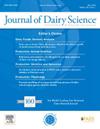The interaction between Lactobacillus delbrueckii ssp. bulgaricus M-58 and Streptococcus thermophilus S10 can enhance the texture and flavor profile of fermented milk: Insights from metabolomics analysis
IF 3.7
1区 农林科学
Q1 AGRICULTURE, DAIRY & ANIMAL SCIENCE
引用次数: 0
Abstract
Lactobacillus delbrueckii ssp. bulgaricus M-58 (M58) and Streptococcus thermophilus S10 (S10) are both dairy starter strains known for their favorable fermentation characteristics. Therefore, this research aimed to study the effects of 1-d low-temperature ripening on the physicochemical properties and metabolomics of fermented milk. Initially, the performance of single (M58 or S10) and dual (M58+S10) strain fermentation was assessed, revealing that the M58+S10 combination resulted in a shortened fermentation time, a stable gel structure, and desirable viscosity, suggesting positive strain interactions. Subsequently, nontargeted metabolomics analyses using liquid chromatography-MS and GC-MS were performed to comparatively analyze M58+S10 fermented milk samples collected at the end of fermentation and after 1 d of low-temperature ripening. The results showed a significant increase in almost all small peptides and dodecanedioic acid in the samples after 1 d of ripening, although there was a substantial decrease in indole and amino acid metabolites. Moreover, notable increases were observed in high-quality flavor compounds, such as geraniol, delta-nonalactone, 1-hexanol,2-ethyl-, methyl jasmonate, and undecanal. This study provides valuable insights into the fermentation characteristics of the dual bacterial starter consisting of M58 and S10 strains and highlights the specific contribution of the low-temperature ripening step to the overall quality of fermented milk.
保加利亚乳杆菌 M58 和嗜热链球菌 S10 之间的相互作用可增强发酵乳的质地和风味:代谢组学分析的启示。
德尔布鲁贝克乳杆菌(Lactobacillus delbrueckii ssp. bulgaricus)M58(M58)和嗜热链球菌(Streptococcus thermophilus)S10(S10)是两种以其良好的发酵特性而闻名的乳制品启动菌株。因此,本研究旨在研究 1 天低温熟化对发酵乳理化性质和代谢组学的影响。首先评估了单菌株(M58 或 S10)和双菌株(M58+S10)发酵的性能,结果表明 M58+S10 组合缩短了发酵时间,凝胶结构稳定,粘度理想,表明菌株之间存在正向相互作用。随后,利用 LC-MS 和 GC-MS 进行了非靶向代谢组学分析,对发酵末期和低温成熟 1 天后收集的 M58+S10 发酵奶样品进行了比较分析。结果表明,成熟一天后,样品中几乎所有的小肽和十二烷二酸都明显增加,而吲哚和氨基酸代谢物则大幅减少。此外,还观察到香叶醇、δ-纳内酯、1-己醇、2-乙基、茉莉酸甲酯和十一醛等优质风味化合物明显增加。这项研究为了解由 M58 和 S10 菌株组成的双细菌发酵剂的发酵特性提供了宝贵的见解,并强调了低温成熟步骤对发酵乳整体质量的特殊贡献。
本文章由计算机程序翻译,如有差异,请以英文原文为准。
求助全文
约1分钟内获得全文
求助全文
来源期刊

Journal of Dairy Science
农林科学-奶制品与动物科学
CiteScore
7.90
自引率
17.10%
发文量
784
审稿时长
4.2 months
期刊介绍:
The official journal of the American Dairy Science Association®, Journal of Dairy Science® (JDS) is the leading peer-reviewed general dairy research journal in the world. JDS readers represent education, industry, and government agencies in more than 70 countries with interests in biochemistry, breeding, economics, engineering, environment, food science, genetics, microbiology, nutrition, pathology, physiology, processing, public health, quality assurance, and sanitation.
 求助内容:
求助内容: 应助结果提醒方式:
应助结果提醒方式:


